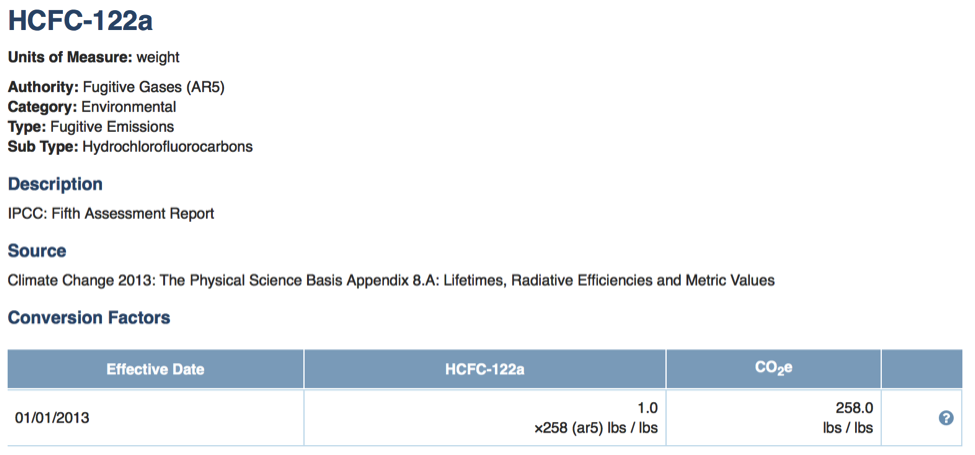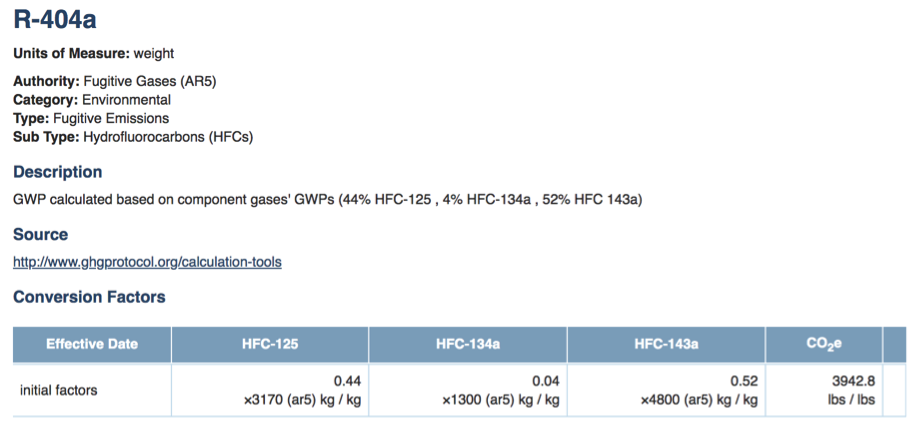Overview
The Scope 5 Fugitive Gases (AR5) library includes emissions factors for a broad set of fugitive gases (often referred to as refrigerants). This library is intended to be used to quantify emissions resulting from activity that emits a single specific fugitive gas, whether blended or not.
In the case that a certain activity emits a combination of gases, it may be preferable to create a custom resource for the activity. See this article.
Where the Numbers Come From
Before discussing the specifics of this library, we begin with a brief orientation on the format and content of resource libraries in general, as the AR5 library differs from other libraries.
Generally, resources in resource libraries include several emissions factors, as follows:
- A factor quantifying the weight of each greenhouse gas (GHG) emitted as a result of a unit of activity (we’ll refer to these as the activity-to-gas factors). For most resources, there are three such factors - CO2, CH4 and N2O.
- A factor quantifying the CO2e (CO2 equivalent), calculated by multiplying the weight of each GHG by its global warming potential (GWP) and summing the products.
In this library, since the activity itself is the emission of a known weight of one specific greenhouse gas there is a single activity-to-gas factor. This factor is always ‘1’ (except in the case of blends, discussed below). In addition, there is a CO2e factor which is simply the GWP of the gas.
These GWPs are taken from Appendix 8.A: Lifetimes, Radiative Efficiencies and Metric Values of the IPCC’s Fifth Assessment Report. This report publishes GWPs for over 200 gases. The Scope 5 library includes the most common of these (101 as of March 2020).
What's Included
Scope 5’s Fugitive gases (AR5) library follows the GHG Protocol’s categorization of fugitive gases (with one additional category - Refrigerant Blends):
- Core gases
- Fluorinated ethers
- Hydrocarbons and other compounds - direct effects
- Hydrochlorofluorocarbons (HCFCs)
- Hydrofluorocarbons (HFCs)
- Perfluorinated compounds
- Perfluoropolyethers
- Substance controlled by the Montreal Protocol
- Refrigerant Blends
All fugitive gases in the first eight categories follow the methodology described previously, to include two emissions factors; a factor of ‘1’ for the gas itself and its GWP, and one additional factor for CO2e. An example of a resource for one gas of this type is illustrated below:

Refrigerant Blends
The 9th category in the Scope 5 library includes resources for fugitive gases that are blends of other fugitive gases. The emissions factor for each component gas indicates the proportion of the blend that the gas makes up (e.g: 0.44 means a 44% for HFC-125 in the example below). Each of these factors is then multiplied by that component’s GWP and the products then summed to produce a CO2e factor for the blend. See the Scope 5 resource for R404a below as an example:

Fugitive Gases not in Scope 5’s Library
If you would like to report on a gas that is not included in the Scope 5 library, you have two options:
- If the gas is broadly used and its GWP is quantified by a reputable source, please contact our team and we will consider adding it to our standard library.
- Create a custom resource in your account’s resource library. To learn more about how to create custom resources, please read the article “Using Scope 5 Resources to Quantify Fugitive Emissions”.
Updates
This resource library is current through the GHG Protocol's 2017 release and the IPCC's Fifth Assessment Report.
The Scope 5 team is always available to help, whether that means navigating the application, making changes to your account configuration or just answering questions.
Comments